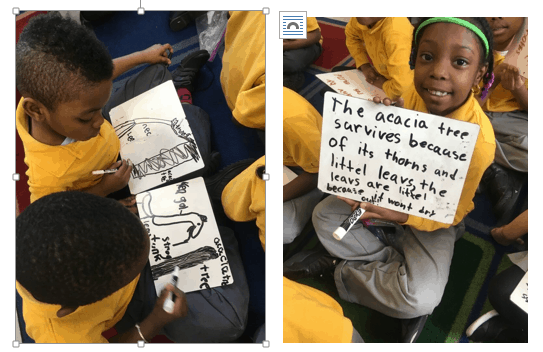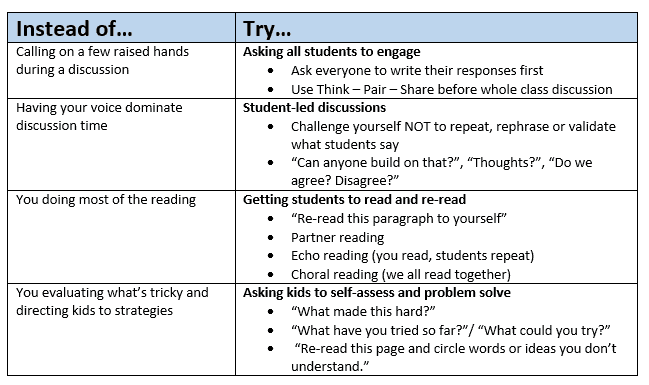“Wah waah wah waah wah wah…” We all know the famous muted trumpet of adults in Charlie Brown’s world, especially their teacher, Miss Othmar. After five years teaching elementary school, I’m confident that I’m not boring my kids to sleep but I do wonder if I strike the right balance between “teacher talk” and student work.
Research has long supported the idea that students benefit from “doing.” Regular practice with reading and re-reading increases comprehension and fluency (National Reading Panel, 2000), as well as builds vocabulary and knowledge (Cunning & Stanovich, 1998). Students also need ample time to connect reading and writing to speaking and listening, integrating their literacy skills (see Appendix A). This is especially important for younger children and English Language Learners, whose oral language far outpaces the ability to read and write (Fisher, Frey, & Rothenberg, 2008).
As we all do our best to help students meet the high bars we set in our literacy classrooms, could it be that we’re missing out on opportunities for kids to do the very work that will help get them there?
What if we did less and let students do more?
Enter the “Who’s Doing the Work?” pilot project! This challenge took its name, and many of the great ideas used, from the book Who’s Doing the Work by Jan Burkins and Kim Yaris. This book is full of small, but powerful, suggestions for adjustments to practices that fit a balanced literacy framework for instruction. Many of these suggested adjustments were used in our strategy sheet. In the pilot, several teams of teachers across the country set out to give students more ownership by decreasing “teacher talk.” Some teams met during PLCs; others were coached 1:1, and a few even videotaped themselves. We selected new strategies to implement and then came back together to reflect on their impact.
Our hope was that by increasing opportunities to engage deeply with literacy, we could create richer opportunities for all students. After six weeks, more than 90% of teachers who engaged in this project reported that they talked less and that students were more engaged. All teachers named this work as a valuable use of their time!
Here are some tips that “Who’s doing the Work?” participants found most effective in their classrooms. A full list of strategies can be found in the document attached at the top of this post.
Ask all students to engage in the work
Rather than calling on a few raised hands, use Think-Pair-Share or Everybody Writes after posing a meaty question. This gives all students the time they need to process their thoughts before opening it up to the whole group. During complex text read-alouds, my co-teacher and I used individual whiteboards so our first graders could jot or draw responses. As an added bonus, we were able to see nearly all student thinking (versus only hearing from a few students).
Ideas for access to inexpensive whiteboards

Let student voices shine!
Too often, classroom discourse is a “Ping-Pong game” between the teacher and one student at a time: teacher initiates question, student responds, teacher evaluates response (for example: “Good job!”), and the cycle continues. One teacher in this project admitted, “I never even knew I did that until I started recording myself!” Challenge yourself to create more of a “volleyball” discussion by asking students to listen to one another and respond to each other’s ideas before tapping the ball back to your side of the court (think Speaking & Listening Anchor Standard 1!). My classroom uses silent hand signals for “I agree,” “I disagree,” or “I’d like to add on.”
Increase time students spend reading
The more our students are doing the reading, the better! To mix things up or provide strategic support, consider using partner reading, echo reading (teacher reads section, students repeat) or choral reading (we all read together). Our teachers found combining re-reading with annotation or searching for evidence to be a particularly great way to get students engaged with text and prepared for discussion!

Build independence
How many times have I told students, “Watch out, this part is going to be tricky!” and modeled or prompted them to use a specific strategy? While this may have helped them get through the challenge of that text or question (and kept the lesson moving smoothly), it probably wasn’t very transferable to their independent practice. Asking kids to evaluate what is tough and how they might sort it out flexes the muscle they’ll need to do this work on their own!
So ask yourself how much time you spend talking in your classroom. Give your voice a break and let’s put students to work!
For more information on observable actions that demonstrate student ownership see Core Action 3 in the Instructional Practice Guide tool on Achieve the Core.



















This is good. I am a first year teacher coming from the business environment to the classroom. I can use more tips like this. Thank you.
Found interesting
This was such a useful article. I will be sure to utilize this tool in the future! Thank you!